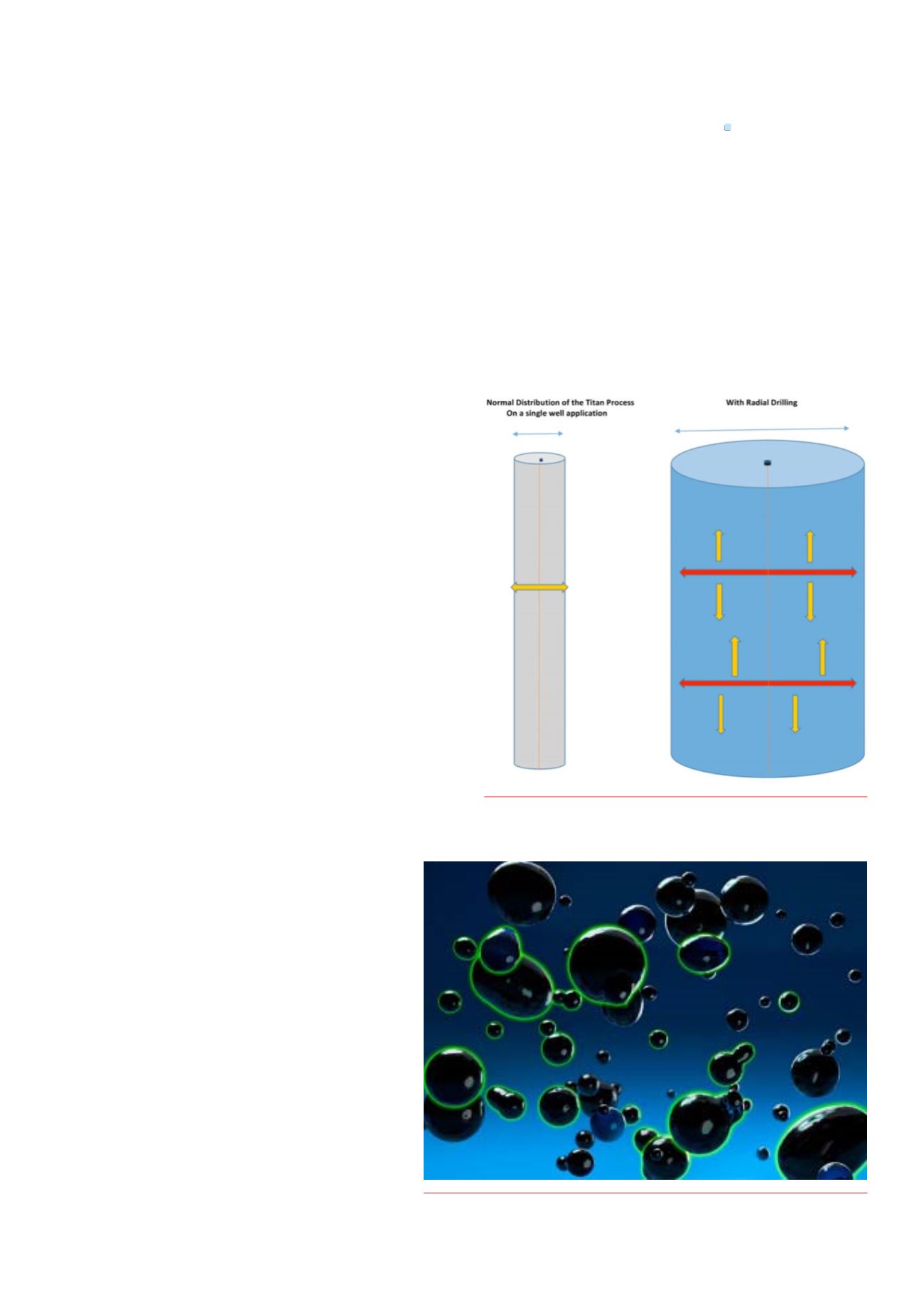
May/June 2020
Oilfield Technology
|
43
The normal nutrient saturation from the wellbore for a single
well application is expected to increase in all directions. The
nutrients and the affected microbial populations also diffuse further
into the surrounding rock. With a simple radial drill hole in four
directions (north, south, east and west) from the wellbore from two
levels, as shown in Figure 2, nutrients injected would be able to
saturate a much larger volume of reservoir rock. After pilot testing
Titan could extend radial drill holes further in each direction. This
could allow for significantly more of the rock matrix to be influenced
by the process.
The combination of pushing out the OOR nutrients to a much
wider areal extant from the wellbore should have a positive effect on
contacting more microbes and creating the micro oil droplet effect
that has worked well in the past. Figure 4 shows micro oil droplets
surrounded by microbes.
If the smallbore lateral drilling works, then – with more
advances and R&D on drilling units – it is envisaged these laterals
could be extended by possibly up to 200 m from the wellbore,
contacting significantly more times the hydrocarbon pay matrix. The
advancements would include stronger and more flexible coils and
drilling bits, and smarter drilling units with a GPS tool attached. The
economics of this added technology should be a low-cost way to
contact trapped and residual oil between well spacings.
Titan’s viewpoint on success rests on a logical progression of
assumptions:
Ì
There is trapped oil surrounding the wellbore that can be
100 – 1000 m away, depending on field well spacing.
Ì
The OOR technology works and is a proven science that releases
trapped oil.
Ì
The mechanism is to feed certain microbial species living in the
reservoir by displacing food for them near the wellbore, and
having the food diffuse further into the pay zone.
Ì
If ‘X’ amount of oil can be recovered by feeding microbes that
live near the wellbore, what would be the results of feeding
microbes that are much further from the wellbore?
Ì
Combined with a more extant microbial reaction and the newly
created low pressure zones, new oil flow could be expected.
The results of this technology combination will be reported after
field trials have been completed with the lateral drilling delivery
system.
Casestudies
OOR has been implemented onshore and offshore with over
300 commercial well applications on 48 oilfields.
The Titan Process (OOR) resulted in oil production
increases of 225%, 450%, 100% and 533% on various
Husky Energy test wells in southern Saskatchewan, Canada
1
,
while various Venoco Inc. well tests in southern California saw
oil production increases of 300%, 15%, 27%, and 752% using
the technology.
2
At an OOR application in Texas oil production
increases ranged from 25 – 90% with a dramatic reduction
of water cut.
3
A review of 100 OOR applications has also
documented an average oil production increase of 127% from
pre-treatment rates to post-treatment maximum rates.
4
In these documented applications of the process,
substantial oil production increases sometimes lasted for
more than a year from a single application. The applications
were conducted under various reservoir conditions of oil
gravity, temperature, salinity, viscosities, porosities and
permeability. Including the global applications on injector
wells, the process was successful in improving oil production
in 98% of injector well applications performed to date.
Conclusion
Combining OOR with a hopefully more dynamic application and
delivery technology could create significant improvements in oil
recovery for oil wells throughout the world.
References
1.
TOWN, K., SHEEHY, A.J., and GOVREAU, B.R., ‘MEOR Success in Southern
Saskatchewan’, Paper SPE 124319 presented at SPE Annual Technical
Conference and Exhibition, 4 – 7 October 2009, New Orleans, Louisiana, US.
2.
ZAHNER, R.L., GOVREAU, B.R, and SHEEHY, A.J., ‘MEOR Success in Southern
California’, Paper SPE 129742 presented at SPE Improved Oil Recovery
Symposium, 24 – 28 April 2010, Tulsa, Oklahoma, US.
3.
AKINTUNJI, A.A., SHEEHY, A.J., MARCOTTE, B.W.G., and GOVREAU, B.R., ‘A
Texas MEOR Application Shows Outstanding Production Improvement Due to
Oil Release Effects on Relative Permeability’, Paper SPE 154216 given at SPE
Improved Oil Recovery Symposium, 14 – 18 April 2012, Tulsa, Oklahoma, US.
4.
ZAHNER, R.L., TAPPER, S., MARCOTTE, B.W.G., and GOVREAU, B.R., ‘What Has
Been Learned from A Hundred MEOR Applications’, Paper SPE 145054 given
at SPE Enhanced Oil Recovery Conference, 19 – 21 July 2011, Kuala Lumpur,
Malaysia.
Figure 3.
Inexpensive smallbore (1 in. dia.) lateral drillingwouldallow
Titan to saturatemore reservoirmatrixwith lateral extensions fromthe
wellbore.
Figure 4.
Micro oil droplets surroundedbymicrobes.








